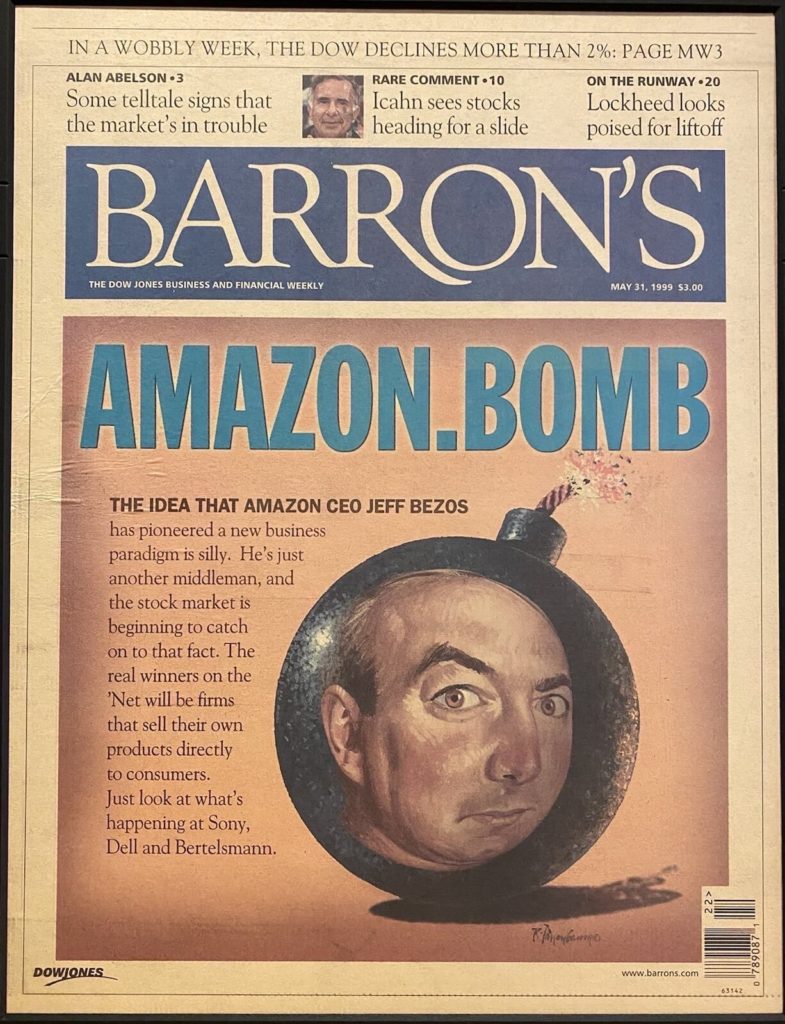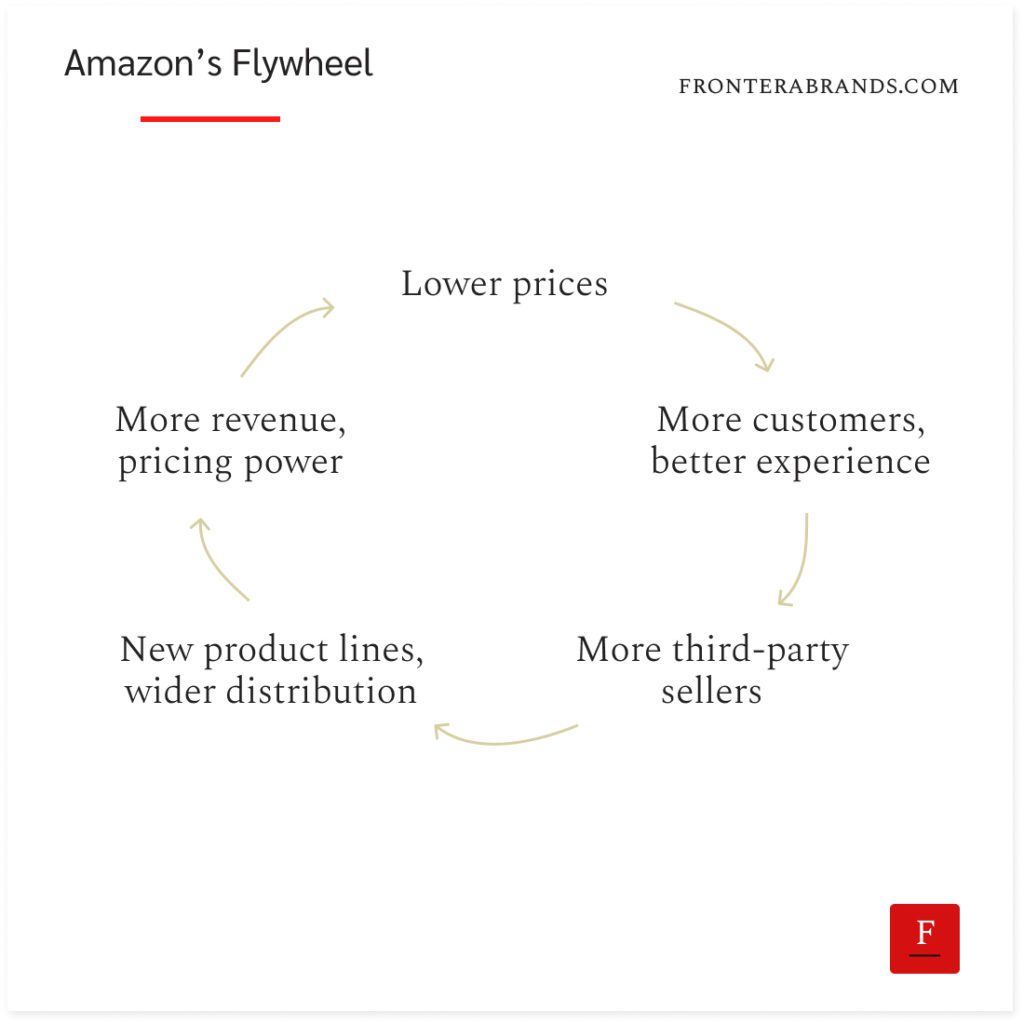What is the flywheel effect?
The Flywheel Effect is a framework that shows how businesses become great by building a virtuous cycle.
Jim Collins defined it in his book Good to Great after he researched patterns of successful companies.
In this article, you’ll see how Jeff Bezos’s meeting with Collins shaped Amazon’s fate. And how to use the flywheel effect for your business.
In 2001, Amazon was in trouble.
The dot-com bubble had popped.
And all tech stocks were crashing to the bottom.
Every week, the news covered a tech company going out of business.
Amazon’s stock also dropped 90%.
So reporters expected Amazon to join other failed companies.

As an optimist, Jeff Bezos believed Amazon could survive the crisis.
But the severity of the crisis created some doubt.
Did Amazon grow only thanks to the dot-com bubble?
Or was it different than other tech companies?
The same year, consultant Jim Collins wrote his book Good to Great.
He had researched the patterns that turn good companies into great ones.
And documented his findings in the book.
It quickly became popular in business circles.
Bezos was hungry for any idea that could help, so he invited Collins to Amazon’s headquarters to get his advice.
Collins spent a few days with Bezos and Amazon’s leadership team.
And explained his insights from the book.
After the meetings, Bezos had one thing in mind.
The flywheel.
Turning the business flywheel
Collins’s research showed that great companies were never born with a single breakthrough.
It was never a miracle product, innovation, or restructuring that made the difference.
They all found a competitive advantage (remember moats).
And built everything around it over the years, until it became a virtuous cycle — where each part of the business amplified the advantage even more.
Collins called it the flywheel effect.
Why did he call it after a mechanical tool?
Because it was like pushing a heavy flywheel.
Flywheel barely moves at first.
But as you push, it slowly gains its momentum.
And if you keep pushing in the same direction for enough time; its weight starts to turn it faster.
Even though you still push with the same force, everything gets easier and easier.
And the flywheel becomes unstoppable.
So Bezos and his leadership team went to the drawing board to think about Amazon’s flywheel.
Amazon had two competitive advantages.
Exceptional customer experience and scale.
How could they amplify these to create a virtuous cycle?
If Amazon kept low prices —despite not being profitable in a crisis— they could attract more customers.
If more customers were on the platform, more third-party sellers would inevitably join.
That would mean more products on the platform and increased revenue and distribution.
And with scale, Amazon could lower prices even more.

Collins’s ideas made Bezos realize the virtuous cycle Amazon had to focus on.
And paved the way to what it is today.
Can any business build a flywheel?
It’s not easy, but simple.
Four steps to use the flywheel effect
1. Find your edge
To build a virtuous cycle, the first step is to find your edge.
Remember Ray Kroc’s story with McDonald’s?
It’s a good flywheel effect example.
He realized the competitive advantage of McDonald’s was not burgers, but Speedee Service System.
So he replicated it in as many locations as possible with the franchising model.
And that created a flywheel effect.
So first think about what can be your edge.
Your uniquely positioned brand?
The way you operate, like McDonald’s?
Or maybe your users switching costs?
Your edge is usually hidden in your past successes.
So study your past to find what can take you to the future.
2. Define the virtuous cycle
The next step is to define a possible virtuous cycle that will amplify your competitive advantage.
I say possible because it takes some experimentation to define the right one.
And the elements to complete the cycle will depend on what your competitive advantage is.
We talked about Amazon and McDonald’s.
Another flywheel effect example is Nike.
Nike’s edge was brand.
So they figured if they found a way to make famous athletes wear Nike, it would amplify their brand power and start a virtuous cycle:
- Famous athletes wear Nike > attract more customers > build brand power > set higher prices to bring more revenue > invent better shoes > more famous athletes wear Nike
And it worked.
One thing to keep in mind here.
You might have to make counterintuitive decisions to turn the flywheel into reality.
They won’t make sense in the short term.
Like when Amazon kept low prices despite not being profitable.
Or when Nike paid tons of money to athletes even when it was a small company.
But that’s how you keep building momentum.
So define your virtuous cycle, and do what it takes to build it.
3. Push the flywheel in one direction
After Bezos figured out Amazon’s flywheel, all his decisions had one aim.
To turn the flywheel faster.
So he designed everything according to that — from department budgets to return policies.
That way, each part of the business worked to reinforce the virtuous cycle.
So any activity that pushes the flywheel in different ways is a distraction.
Cut them out (remember via negativa).
4. Never interrupt the flywheel
In his book, Collins mentions why most good companies never become great.
Because they interrupt the flywheel.
Sometimes a new CEO comes in and changes everything.
Sometimes executives want to follow a new tech trend by building everything again from scratch.
So all the cumulative effort goes to waste.
Flywheels take time to gain momentum.
In a world where everybody is impatient, never interrupt the flywheel to stay in your path from good to great.
–
Enjoyed this article?
Then you’ll love the How Brands Win Newsletter.
Get the “7 Positioning Sins That Cost B2B Brands Millions” guide when you join. It’s free.
